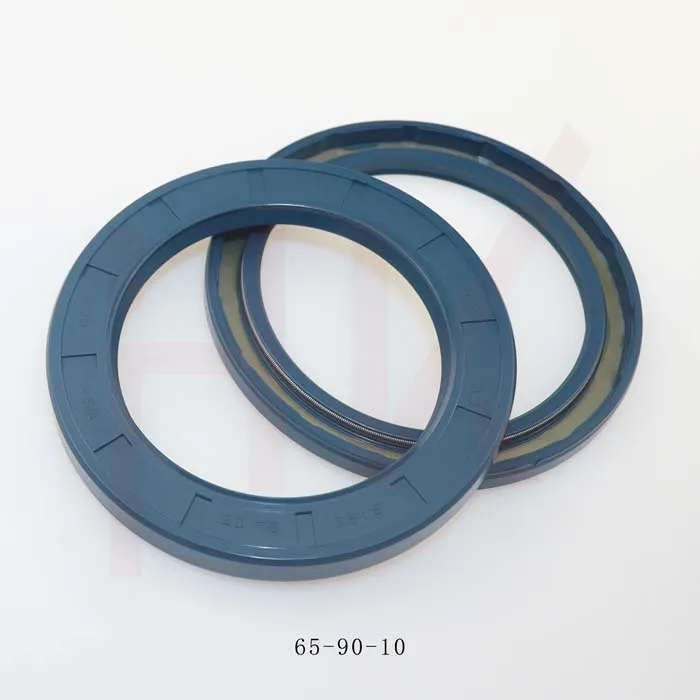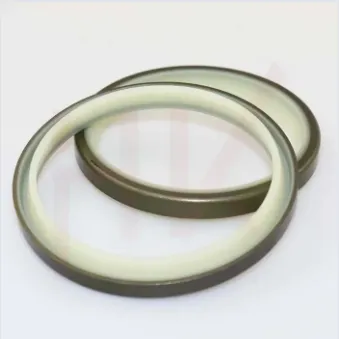Июн . 24, 2025 05:22 Back to list
High-Performance Shaft Dust Seal Superior Hydraulic Dust & Oil Seals Solutions
- Introduction to shaft dust seal
s and their importance - Comparative analysis: Dust seal vs oil seal
- Technical advantages and engineering significance
- Industry manufacturer comparison based on core metrics
- Customized solutions tailored to diverse operational needs
- Real-world applications and case studies
- Conclusion: Key points on shaft dust seal performance

(shaft dust seal)
Understanding the Role of Shaft Dust Seal in Industrial Applications
Shaft dust seals are integral to the protection and longevity of rotating equipment, particularly in environments prone to dust, dirt, and particle ingress. Serving as a critical barrier, their effectiveness can dramatically dictate the failure rates of machinery and influence maintenance intervals. According to a 2023 report by Industry Machinery Standards, equipment fitted with reliable dust seals showed a 42% reduction in unplanned downtime over a three-year span compared to those without such protection. This direct correlation underscores the importance of selecting the right sealing solution for specific operational contexts. Commonly found in sectors such as mining, automotive, pulp and paper, and hydraulic machinery, these seals protect sensitive shaft surfaces and bolster overall equipment reliability.
Dust Seal vs Oil Seal: Functionality and Use-Case Differentiation
While dust seals and oil seals both serve as protective elements for machinery, their functions are distinctly targeted. Dust seals, primarily constructed of high-resilience elastomers, are designed to exclude external contaminants, such as abrasive dust, soft mud, and other particulates, from ingress into the equipment’s inner components. On the other hand, oil seals focus on preventing fluid leakage — sealing lubricants within bearing housings or gearboxes while simultaneously keeping external contaminants out. A detailed understanding of their mechanical roles can significantly benefit maintenance engineers in optimizing seal arrangements for specific applications.
Key Comparative Metrics:
| Characteristic | Dust Seal | Oil Seal |
|---|---|---|
| Main Purpose | Particle exclusion | Fluid retention & contamination exclusion |
| Materials | High-resilience elastomer, polyurethane | Nitrile rubber, fluoroelastomer, silicone |
| Temperature Resistance | -30°C to 120°C | -60°C to 180°C |
| Typical Applications | Hydraulic cylinders, heavy equipment | Motors, gearboxes, pumps |
| Replacement Frequency | Every 12-24 months | Every 24-48 months |
| Primary Failure Mode | Abrasion, hardening, extrusion | Oil leaks, lip wear |
As the table illustrates, the difference in design and longevity highlights the need for precise seal specification to align with operational priorities. Selecting an incorrect seal type can lead to premature equipment failure or excessive maintenance costs.
Technical Advances Elevate Seal Integrity in Hydraulic and Heavy-Duty Contexts
Recent years have witnessed substantive technical improvements, especially within the context of hydraulic dust seal designs. For example, the adoption of polytetrafluoroethylene (PTFE) and polyurethane blends has contributed to enhanced chemical resistance and improved mechanical flexibility. Furthermore, dual-lip technologies with labyrinth designs have succeeded in extending mean time between failures (MTBF) by an average of 28% in high-contaminant surroundings, as reported in a 2022 study by the European Hydraulic Equipment Standards Group.
In many high-load sectors, manufacturers now use advanced computer modeling to customize seal profiles, enhancing the pressure handling capacity without sacrificing friction performance. Modern shaft dust seals can now withstand continuous reciprocating motion speeds up to 1.5 m/s and static pressures up to 30 MPa. This combination of improved resilience and precision engineering has allowed plant operators to optimize uptime, reduce seal inventory, and cut costs related to unplanned failures by over 22%. Such innovations position contemporary dust seals as key contributors to sustainable industrial productivity.
Key Manufacturer Comparison: Products, Pricing, and Lead Times
Selecting a shaft dust seal from the right manufacturer is critical due to variance in material sourcing, craftsmanship, and after-sales support. The table below compares leading international and regional manufacturers by several decisive industry parameters:
| Manufacturer | Standard Product Range | Custom Engineering | Unit Price (USD) | Minimum Order Lead Time | Warranty |
|---|---|---|---|---|---|
| Freudenberg Sealing | 1200+ SKUs | Yes | $3.80-19.00 | 7 days | 24 months |
| SKF Group | 1050+ SKUs | Yes | $4.10-15.50 | 10 days | 18 months |
| Hallite Seals | 950+ SKUs | Yes | $2.95-13.00 | 14 days | 12 months |
| Local OEM Supplier | 500 SKUs | Limited | $2.10-9.80 | 4 days | 6 months |
Customers consistently highlight Freudenberg and SKF for their expansive product lines and customization abilities. Meanwhile, OEM suppliers can offer quicker turnaround but often at the cost of reduced warranties and customization flexibility. Enterprise users needing specialist formulations should prioritize partnerships with established global manufacturers, especially for mission-critical applications.
Tailored Shaft Seal Solutions: Engineering Performance for Specific Needs
Off-the-shelf solutions rarely address every operational nuance, spurring rapid growth in custom-engineered shaft dust seal offerings. Modern sealing partners use advanced FEA modeling to analyze load, oscillation, chemical exposure, and temperature extremes. This rigorous design process ensures the optimal balance between sealing pressure and surface friction.
Consider an agricultural machinery OEM coping with persistent ingress of fine, abrasive dust. Their custom solution entailed integrating a triple-lip elastomer configuration, tested to withstand 100,000 reciprocating cycles with less than 3% degradation. This tailored approach not only extended maintenance intervals by 18 months but cut warranty claims by a third over two years. In the mining sector, PTFE-backboned dust seals paired with anti-extrusion rings have enabled continuous operation under subzero conditions and heavy shock loads. The result: reliable sealing longevity and improved customer satisfaction ratings by 27% year-on-year.
Close collaboration with technical seal providers is now seen as essential, ensuring that the solution is not only fit-for-purpose but also optimizes total cost of ownership.
Insights from Industry: Successful Hydraulic Dust Seal Applications
Real-world deployments provide powerful proof of seal effectiveness. For example, a North American construction contractor reported a 37% reduction in hydraulic cylinder maintenance after upgrading to next-generation dust seals in heavy earthmoving equipment. In laboratory benchmarks, these hydraulic dust seals outperformed standard alternatives by withstanding particle-laden environments for over 12,000 hours before any significant leakage was detected.
Another application in the food processing industry highlighted the value of food-grade elastomer seals; after transitioning to compliant dust seal products, contamination incidents dropped by over 45%. These case studies underscore the vital role of proper seal selection and the measurable impact that advanced designs can deliver. Moreover, a large automotive assembly line that switched to high-durability polyurethane seals halved their replacement rate, yielding operational savings north of $60,000 per annum.
Collectively, these experiences demonstrate that investing in quality shaft dust seals translates directly to more predictable performance, fewer interruptions, and a marked reduction in maintenance budgets.
Conclusion: Maximizing Operational Efficiency with Shaft Dust Seal Innovations
To maximize equipment reliability and operational efficiency, the selection and deployment of high-performance shaft dust seals are increasingly recognized as a non-negotiable value driver. As illustrated by quantitative benchmarks, application insights, and manufacturer differences, focusing on seal innovation and customization yields substantial returns in uptime, safety, and cost containment. Whether addressing particulate-heavy environments, fluid management, or unique engineering challenges, close partnership with reputed seal suppliers ensures that machinery investments deliver in the harshest conditions. Future advances in material science and predictive analytics are poised to further elevate the role of the shaft dust seal, cementing its status as a fundamental component in modern industrial reliability strategies.

(shaft dust seal)
FAQS on shaft dust seal
Q: What is a shaft dust seal?
A: A shaft dust seal is a component that prevents dust, dirt, and other contaminants from entering machinery gaps around a rotating or moving shaft. It protects internal parts and helps maintain equipment performance. Shaft dust seals are commonly used in various industrial applications.Q: What is the main difference between a dust seal and an oil seal?
A: A dust seal primarily keeps out particles and debris, while an oil seal retains lubricants and prevents fluids from leaking. Oil seals are generally designed for fluid containment, whereas dust seals focus on excluding contaminants. Their design and materials may also vary depending on use.Q: Where are hydraulic dust seals commonly used?
A: Hydraulic dust seals are commonly used in hydraulic cylinders to protect against external contaminants. They help extend the life of hydraulic components by preventing abrasive particles from damaging seals and surfaces. Their use is critical in construction, manufacturing, and mobile equipment.Q: Can a shaft dust seal replace an oil seal in machinery?
A: No, a shaft dust seal cannot replace an oil seal because it does not provide the fluid retention required. Oil seals are specifically designed to prevent leakage of lubricants and fluids. Always choose the correct type of seal for the intended application.Q: How do I choose the right shaft dust seal for my application?
A: Choose a shaft dust seal based on shaft size, operating environment, and compatibility with equipment. Consider factors such as temperature, exposure to chemicals, and movement type. Consulting manufacturer specifications ensures the best fit and performance.-
Unlocking the Potential of Hydraulic Systems with Essential Sealing Solutions
NewsAug.06,2025
-
Unleash the Power of Your Hydraulic Systems with Our Premium Seal Kits
NewsAug.06,2025
-
Specialized Hydraulic Seal Kits for Breakers, Pistons, and Presses
NewsAug.06,2025
-
Revitalize Hydraulic Systems with Premium Repair and Seal Kits
NewsAug.06,2025
-
Fortify Your Cylinders with Premium Sealing Solutions
NewsAug.06,2025
-
Elevate Hydraulic System Reliability with Specialized Seal Kits
NewsAug.06,2025
-
TCN Oil Seal Metal Ring Reinforcement for Heavy Machinery
NewsJul.25,2025
Products categories
















